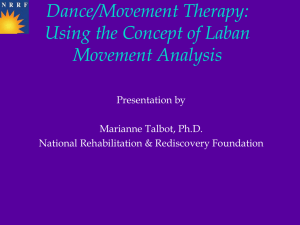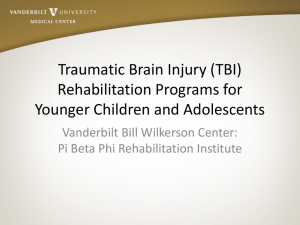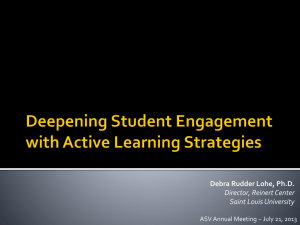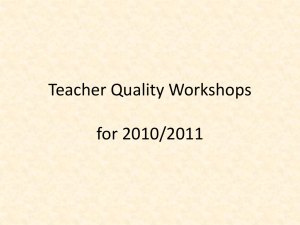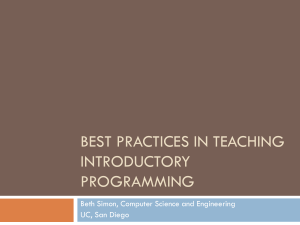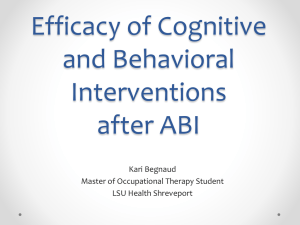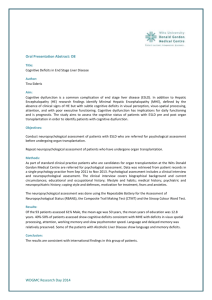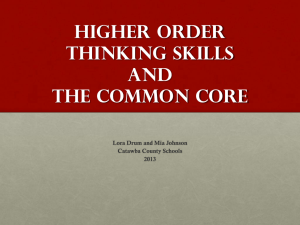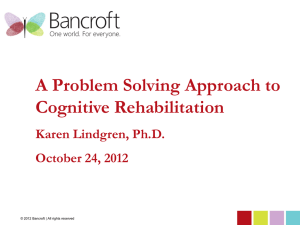Neuropsychological Evaluation
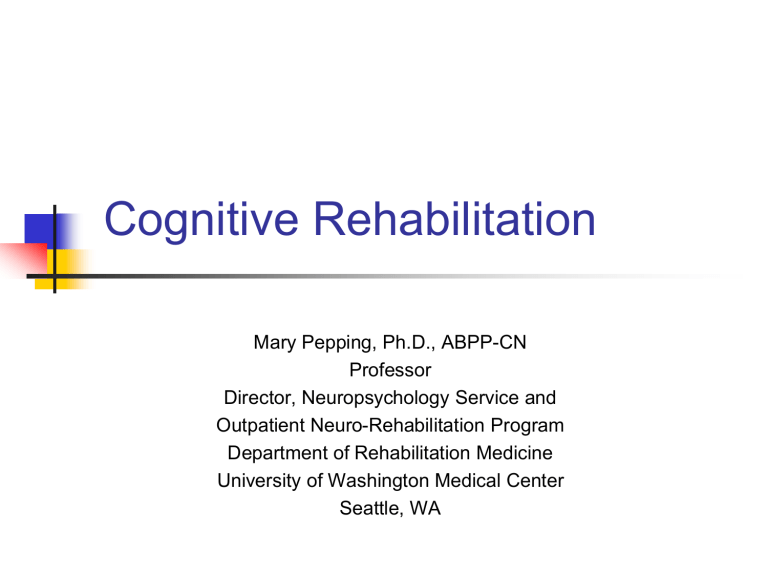
Cognitive Rehabilitation
Mary Pepping, Ph.D., ABPP-CN
Professor
Director, Neuropsychology Service and
Outpatient Neuro-Rehabilitation Program
Department of Rehabilitation Medicine
University of Washington Medical Center
Seattle, WA
Cognitive Rehabilitation
What is it?
Evidence-based, systematic treatments designed to improve thinking performance
One important component of effective neuro-rehabilitation
Who provides it?
Neuropsychologists, speech pathologists, occupational therapists
Evidence for effectiveness of
Cognitive Rehabilitation
There is a literature on this topic
(handout list available at front)
Can we teach people how to think more effectively?
How do you train people to apply that good thinking more effectively in life?
What are the barriers to effective function?
Barriers to treatment benefit for improved cognitive function
Very severe cognitive or behavioral impairments that prevent participation
Inability to pay attention
No demonstrated evidence of ability to learn new information or prodecures
Active drug or alcohol abuse
Aggressive behaviors
Suicidal behaviors
Psychotic hallucinations, delusions
Cognitive Rehabilitation:
How does it work?
Determine “upstream” or underlying sources of cognitive deficits
Teach the patient techniques to manage or improve those deficits
Drill the techniques until they become overlearned, automatic procedures
Practice the techniques in a range of settings: clinic, home, community, workplace, school
Role of Neuropsychological
Evaluation in Cog Rehab
Comprehensive evaluation to identify overall level of skills and deficits and specific features of ability and difficulty
What are primary obstacles to improved thinking and function?
How does the person learn best?
What kinds of techniques are they able to manage and accept?
Common Neurocognitive
Problems in TBI/ABI
Complex Attention
Screening out distractions
Maintaining one’s focus
Multi-tasking
Complex Memory
Acquisition
Retrieval
Executive Functions
Main Idea Development, Inferences, Planning,
Organization, Higher level problem solving
Speed of information processing
Complex Attention –
Screening out Distractions
Basic techniques for work or home tasks:
Reduce environmental noise and clutter
TV, radio, iPod off
Phones and electronic devices muted
One project at a time on desk or desktop
Create blocks of “no interruptions” time
Use re-direction for inner distractions, e.g.
“I’m doing (THIS TASK ONLY) now”
Quickly jot down distracting ideas then ignore
Complex Attention:
Multi-Tasking at Work
Reduce incoming information load
Smaller group meetings
Focused agenda
Note-taking help
One person talks at a time
Send out summary for feedback
Use email when possible for incoming and outgoing ideas and plans
Complex Attention:
Multi-tasking at home
Practice with two tasks:
Laundry and cooking
Bill paying and answering phone
Use electronic supports to cue you
Set timers/alarms to check tasks
Remind self of two tasks – post notes
Note on door to garage to check tasks
Memory Acquisition
Divide and Conquer:
Organize new information into fewer and more meaningful sub-groups
Learn how to take good notes
Main ideas and key details
Record and review soon after
Correct notes, write summary
Memorize the main ideas and key words
Memory Acquisition
In conversation
Ask speaker to talk more slowly if needed
Briefly summarize points of conversation
Clarify confusion by asking questions
Jot down notes as soon as possible
Call to double-check you have it right
Memory Retrieval
Review your notes prior to your next meeting or conversation and refer to them as needed during meeting
Practice recalling main points of what you hear or read before meeting
Use helpful mnemonic devices, e.g., link name of new person to something that will help cue you to their name
Electronic Devices
Smart phones – iPhone, Droids,
Blackberrys, Palm
Schedules of appointments
Who, what, when, where, why
Names, addresses and phone numbers
To do lists, shopping lists
Special alarm tones linked to specific tasks, appts, reminders, people, events
Electronic Devices continued
Sync with your computer – Google calendar, Palm calendar, contacts
Get your kids or grandkids to help you!
Arrange for computer support
Use dictation software
Get assistive technology consultation at your medical center
Executive Function:
Main Idea Development
Start with professional help: SP, NP, OT
How to determine main ideas
“What is the article or program about?”
Summarize main points in 2-3 sentences
Using “telegram” technique to winnow down to one or two essential ideas, e.g., can you create a 7-10 word telegram that conveys basic topic?
Executive Function:
Main Idea Development con’t
Reading comprehension
Usually one main idea per paragraph
Use title, first and last sentence as cues
Look for people, events, actions, ideas
Jot down key ideas, characters as you read
Write a summary note
Explain what you have read to someone else
Ask yourself questions about the topic, look for answers in the article
Start with something brief and manageable
Executive Function:
Organization, Problem-Solving
Get professional help to set up strategies and systems – SP, NP, OT
Practice systems on real projects
ABODES systems
A ssess situation, B reak into steps, O rder the steps chronologically, D etermine what supplies or personnel are needed, E stimate time to complete each step, S urvey work as it proceeds to make needed corrections.
Executive Function:
Organization continued
Consider hiring a home organizer
Divide and conquer – do not tackle all your projects or problems at once
Schedule specific times to tackle the task, pace yourself, reward yourself
Get a well-organized friend to help you sort through papers or belongings, e.g., the “Yes, No, Maybe” system
Higher Level Problem Solving
Use of a grid/table for figuring out best options: e.g., travel plans
What are all of the variables to consider?
What are your preferences and limits:
Where to go (family visit, foreign travel, U.S?), with whom, budget, time for trip, airline miles, hotel preferences/credits, preferred activities, travel ins., energy levels, medical needs, cancellation policies
Airlines/Airplanes, Hotel/Rental, Ground transport, Meals, Entertainment, Clothing
Meta-Cognitive Skills
“The Big Picture”
What is the best approach for a particular kind of problem or task?
Where do main points work best?
Brief conversations
Email communication at work
Basic To-Do Lists
MetaCognitive Skills (con’t)
Where do you need added details
Complex projects and plans
Multi-step errand lists
Priority items (Bank, Post office, Dry cleaners, Store)
Geographic layout of locations
What needs to be done at each place?
Bank: Deposits, cash check
Post office: Pick up package, buy postage
Drop off three items, schedule P/U date in book!
Buy groceries for party (bring list!)
Other general supports for improved cognitive function
Appropriate use of medications
Pacing of activities
Exercise
Fatigue Management
Treatment of depression, anxiety
Make sure vision and hearing are as good as possible
Cognitive Rehabilitation:
General supports continued
Create and maintain efficient weekly schedules for routine tasks so they become automatic habits
Develop and use only one memory system for calendar, schedule, to do list
Pick one specific practical problem to change, work on that, make it better, then tackle the next one
Practice thought-stopping to redirect your attention and stick with your task or plan
Cognitive Rehabilitation
A critical component of neuro-rehabilitation
Targets each patient’s key cognitive hurdles
Develops hierarchical plan of intervention, e.g., upstream or underlying issues first
Teaches patient awareness of + and -
Trains specific approaches to problems
Extends strategies to real life settings
Teaches metacognitive skills (how to observe, understand and change thinking)

